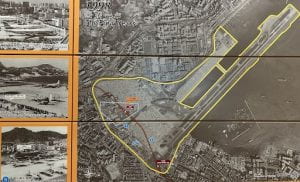Kai Tak Airport, located in the Kowloon region, holds a special place in aviation history. Its distinctive runway and the infamous “Kai Tak Heart Attack” landing approach made it one of the world’s most challenging airports.
The Birth of a Legend
Kai Tak Airport evolved from a modest British Royal Air Force airstrip in the 1920s to a bustling commercial airport around the 1930s. It experienced relentless expansion, even during World War II (WWII) when it primarily served as a military base. After WWII, Kai Tak underwent further expansion and modernization to meet the growing demand for air travel. Its famous single runway (Runway 13/31) was extended into Victoria Harbour by reclaiming land, posing a unique challenge for pilots and air traffic controllers.
The “Kai Tak Heart Attack” Approach
What made Kai Tak Airport truly legendary was its iconic single runway (Runway 13/31). This runway required pilots to navigate a series of sharp turns and descents while avoiding tall buildings and mountainous terrain. Pilots usually had to make a 47-degree turn – known as the “Checkerboard Turn” – to land safely. Pilots had to display their finest skills to execute this “Kai Tak Heart Attack” approach, and there was no room for error.
Legacy and Closure
Over several decades, Kai Tak Airport played a pivotal role in Hong Kong’s development as a tourist destination and an international business hub. However, as the demand for air travel continued to grow, Kai Tak faced several challenges, including noise concerns in densely populated urban areas and very limited expansion options.
In July 1998, after serving Hong Kong for over six decades, Kai Tak Airport was closed, marking the end of an era. Prior to its closure, Kai Tak Airport had the third-largest volume of passengers and the largest freight volume in the world. The operations of air transportation were relocated to the newly built Hong Kong International Airport on Lantau Island, which offers more extensive runways, 24-hour operation, and modern facilities.
Today, the former airport runway and airport grounds of Kai Tak have been transformed into a vibrant urban district known as Kai Tak Development (KTD), featuring residential, commercial, and recreational spaces. This development has preserved some of the airport’s history and integrated it into the fabric of the neighborhood. The metro station exits still showcase the fascinating history of Hong Kong (see the picture taken from the Kai Tak metro station).

Conclusion
Kai Tak Airport remains a legendary icon in the world of aviation, remembered for its unique challenges and captivating approach. One urban policy researcher at George Washington University has been conducting a research project surrounding the change in urban dynamics, building structure, and associated socioeconomic outcomes after the airport’s closure. This specific case of relocating an urban center-based airport can provide very interesting lessons and experiences for cities with airports located in densely populated city centers.
Bio: Jingwen Zheng is a PhD candidate in Public Policy and Administration at the George Washington University, Washington DC. She is a Sigur Center Summer 2023 Research Fellow
